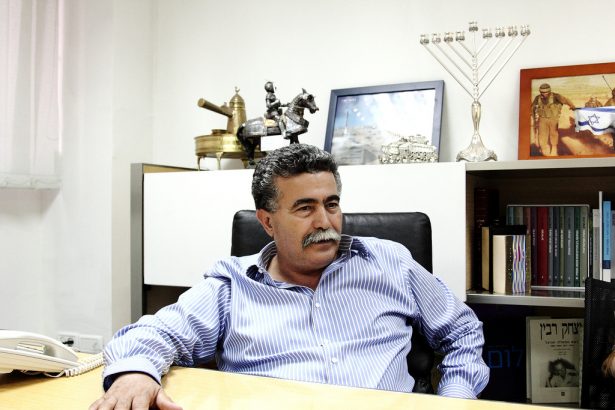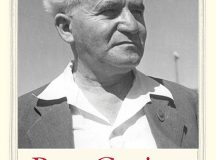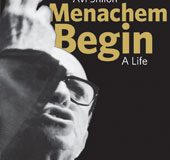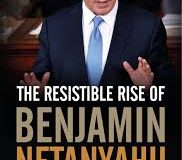Amir Peretz is a Member of Knesset (Labor Party), former defence minister and former minister for the protection of the environment. He has also served as chair of the Labor Party, head of the Histadrut – Israel’s trade union federation – and Mayor of his hometown Sderot. In this article, he focuses on two components of Shimon Peres’ life: his mamlakhtiyut (statesmanship) and pursuit of peace, arguing that these provide a basis to respond to the rising threat of populism. According to Peretz, the choice in Israel is no longer between Left and Right but between nativism, authoritarianism and racism, and Shimon Peres’s legacy of mamlakhtiyut, which seeks to transcend party affiliations and ideological differences for the benefit of all citizens.
There are few people whose lives have been as intertwined with the history of the State of Israel as Shimon Peres. President, Prime Minister, Defense Minister, and Finance Minister are just a few of the titles he held. Not only did he witness the inception of the State, he shaped its character during his long political career. Even more important than the offices he held is the legacy he left behind. Given current trends in world politics, most notably a global populist surge, his style of leadership, his statesmanship and his relentless work for peace remain particularly relevant today.
From our first encounter, when I was the newly elected Mayor of Sderot, and throughout the decades of my political service, Peres and I were not always in agreement. Yet I could see that almost every decision he made reflected enormous foresight, and demonstrated his ability to anticipate global and local repercussions. This is best encapsulated by his early support for a two-state solution.
Peace
Today, the two-state solution is a mainstream view, but it began as avant-garde, even within the Labor Party. Prior to the first Palestinian uprising, or intifada, I was Mayor of Sderot, a former development town bordering the Gaza Strip. At the time there was no physical border between Israel and the Strip, no Palestinian Authority (PA) and no Hamas in government. Though we had relationships with Palestinians on a personal level, it was crystal clear to me that the Palestinians would not give up on the right to self-determination and that controlling them was contrary to the Israeli interest.
I said then the longer we stalled, the bigger and more extreme a future Palestinian state might be. This message was supported by the people of Sderot too, who joined in people-to-people programmes that I promoted when Mayor; but within the Labor Party such a policy was still considered heresy. I was the dovish voice of foreign policy within the hawkish ‘Rabin camp’ (as opposed to the ‘Peres camp’) within the party. After the first intifada there was little doubt among Israelis that a compromise with the Palestinian leadership was necessary. Like most Israelis, I was thrilled that Peres, in the role of Foreign Minister, had convinced Prime Minister Yitzhak Rabin to choose the risky road to peace.
The efforts of successive Israeli and Palestinian leaders – from Rabin and Arafat to Netanyahu and Abbas – were foiled. As a result, the centre of Israeli politics is increasingly apathetic and confused regarding the prospects of peace, while even some core left-wing supporters have become apologetic regarding their own commitment to peace. It is easy to think that the present status quo is dark and less conducive to peace talks than the one Peres and Rabin were working through. However, when a two-state solution is proposed today it is a mainstream idea and even Netanyahu – who has done very little to demonstrate his seriousness about it – feels comfortable mentioning it.
The peace plan for Israel and the Palestinians that I outlined almost two years ago also draws on Peres’s ideas. Essentially the plan consists of negotiations between Israel and the PA that would result in an exchange of sovereignty. Israel would extend its sovereignty over 5 per cent of the West Bank / Judea and Samaria (based on 1967 boundaries) in exchange for equivalent territory. In so doing, 490,000 Jews living over the Green Live, 200,000 residents in East Jerusalem’s Jewish neighborhoods and 290,000 residing in the major settlement blocs – that is 86 per cent of all settlers – would instead find themselves living within the recognised boundaries of the State of Israel.
My own peace plan suggests a detailed timeline for mutual confidence-building measures, including joint measures against violence, terror and incitement and the cessation of efforts by the Palestinian leadership to internationalise the conflict. In parallel, Israel will announce a complete freeze on construction outside the major settlement blocs and declare that negotiations will be based on the 1967 lines, with land swaps that will take current demographic realities into account. The Palestinian leadership, for its part, will declare its goal to be a peace agreement, the end of conflict and finality of claims. In an era of peace, it is expected of Palestine to be established as a demilitarised state with mutually beneficial security arrangements to foster economic growth and prosperity for both peoples.
More sensitive core issues would have to be creatively addressed. As for Jerusalem, Israel would be relieved from the demographic and security threats stemming from holding onto Palestinian neighbourhoods, while Jewish neighbourhoods will remain under Israeli sovereignty. Jerusalem’s historic and holy basic will remain under Israeli sovereignty with a dedicated negotiating team to design a special regime of joint administration, free movement and worship. The refugee question will be resolved within the borders of the new Palestinian State, the homeland for the Palestinian people, and/or within the framework of a major international aid program and agreements with other states in the region.
Mamlakhtiyut
Peres was a politician, not a saint. I challenged him and won in the Labor primaries of 2005. But I could see that he wasn’t driven by the need to make short-term political gains or the furthering of selfish causes. When it mattered most, he was driven by the wish to build a future for the people – all the people.
The Hebrew concept of mamlakhtiyut, most commonly associated with David Ben-Gurion’s premiership, best sums up this quality. Translated into English as ‘statesmanship,’ it goes beyond that. Leaders who behave in mamlakhti display integrity by recognising the responsibility of the authority vested in them. As such, they work to the best of their ability for the good of the state, independent of partisan political considerations and personal aspirations.
The most notable example of Peres’s mamlakhtiyut followed Rabin’s assassination. It would have been very easy for Peres to exploit Rabin’s murder as the right-wing sought to gain power. As a young member of the Knesset at the time, I was closely involved in Peres’s campaign for the premiership following Rabin’s death. I still recall the pressure to use an image of Netanyahu (then leader of the opposition) on billboards to paint him as the exponent of the incitement campaign that preceded the killing of Rabin. Peres rejected that option. He understood that tearing apart an already divided society would have disastrous consequences. He believed in the importance of national unity and was aware of how this must constrain both his and the party’s behaviour.
Mamlakhtiyut is best exemplified by a leader in the way he or she treats those who differ. I recall how deeply invested Peres was in helping my hometown during the 1980s, despite Sderot remaining a conservative stronghold. The people of the town still resented the old guard of the Labor Party – what might today be termed ‘the establishment’. Despite losing the Labor primaries, Peres remained a trusted source of wisdom when I served as Defense Minister. Putting the good of the country before the leader’s ego isn’t always easy, but it’s the essence of good statesmanship.
Populism
In light of the current rise of populism we are seeing in western democracies, we should turn to the style of leadership exemplified by Ben-Gurion and his prodigy, Peres, for inspiration. They were clearly not any less nationalist than contemporary populists, they literally built Israel as a nation state. . But they also embodied a unifying civic nationalism that bears no resemblance to the divisive, ethnocentric breed of nationalism of today’s insurgent populists.
Such tribal populism draws on an ‘us vs them’ narrative. For a long time the ‘Other’ was mainly reserved for Arabs or Palestinians, but in past years we have been witnessing an equally worrying trend in Israeli society: elements on the far-right have sought to vilify the Left, the courts, the media, civil society organisations, academics and senior army officers. This has often been condoned, and sometimes actively supported, by the current government, further contributing to division within Israeli society. Let’s be very clear here: no one has the right to curtail the pluralism that exists in Israel – not even with a parliamentary majority. Democracy isn’t just about who has the majority – in my opinion, democracy is also about how minorities are treated.
It is unlikely that nationalist-populists will become mamlakhti. Their attacks on ‘the establishment’, served with a strange cocktail of tax breaks for the wealthiest and extreme protectionism, may yield short-term gains. Moderate forces are often bewildered by the effects of globalisation and neo-liberalisation, and feel tempted to adopt a populist discourse and to use slogans that dismiss the state and its institutions in the name of ‘the people’. We must not be fooled into adopting similar, racially-driven populism. Divisive politics may work in the short run but eventually the cracks in the foundation of our society will become unbridgeable and we will all lose. One needn’t go as far back as the early 20th century to learn that lesson – just look at the fate of those Latin American countries recently run by populists.
German Professor Ralph Fuchs has pointed out that, ‘Today’s central line of conflict runs between open societies and various forms of identitarian radicalism.’ In the Israeli context, the choice is between nativism, authoritarianism, racism and Peres’s legacy of mamlakhtiyut that seeks to overcome party affiliations and ideological differences for the benefit of all citizens.
To me, the path is clear. Succumbing to fear and division cannot be the answer to today’s problems. Peres’s vision was inclusive and unifying, balancing a strategic commitment to peace and diplomacy with our neighbours, as well as a hard-headed approach to our security and military capabilities. Today, only those who act with foresight and work to heal social wounds will be able to restore faith in the state’s institutions and the system as a whole.






































